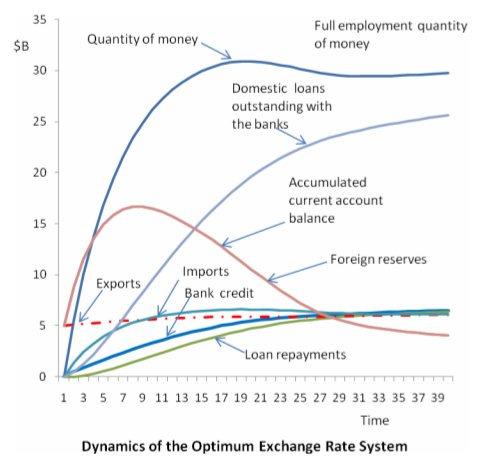Once again Leigh Harkness joins us for a guest post, this time on what he considers the best approach to take in regards to exchange rates for the long term prosperity for the nation. As usual Leigh’s ideas are thought provoking.
Since Leigh has been guest posting at MacroBusiness he has been contacted by some external parties interested in his research. So look out for Leigh in some other places shortly.
The two main exchange rate systems have attributes that are attractive to different sectors of the economy. But is there an exchange rate system that suits all sectors?
The system that we are looking for should ensure stable exchange rates for the productive sectors. Also, it should allow the market to determine the exchange rate and not require the Reserve Bank to use foreign reserves to guarantee the value of the currency. Furthermore, it should work within a deregulated financial system and promote stable interest rates and low inflation.
For the benefit of the government, it should provide full employment and be conducive to a balanced budget. In addition, we would require the system to be sustainable. That is, it should provide balance of payments stability and the current account should be balanced in the long term.
Some of these targets are complementary. To achieve balance of payments and a balanced current account, the excessive demand for imports will need to be redirected to the domestic economy. That shift in demand will provide employment and stimulate investment that will provide additional employment. Increased employment is conducive to a balance budget. It reduces demand for government welfare expenditure and raises tax revenue. Also, the increased domestic supply relative to domestic demand will lower inflation.
The current floating exchange rate system has two basic principles:
- international receipts and payments are required to be equal; and
- the exchange rate adjusts to achieve that objective.
The first principle means that the domestic banking system is the sole source of additional money. To achieve our desired objectives, these principles will need to change. The optimum exchange rate system that I propose changes all these principles. It has two basic principles, also.
The first principle is to require banks to hold foreign reserves and link the growth in their lending to the growth of their foreign reserves. Foreign reserves created when exports exceed imports are national savings. This principle seeks to link bank lending to national savings.
It could be put into effect by allowing banks to lend, say, $10 for every US$1 increase in their net foreign reserves. If banks were to lend excessively, they would deplete their foreign reserves and that would constrain them from further lending until these savings were replenished.
Banks could not add to their net foreign reserves through direct international borrowing. However, if there were a shortage of credit, the wider finance market could raise interest rates to attract foreign capital into the economy. Even so, bank credit from domestic savings would be a cheaper source of funds. In the long term, interest rates would stabilise at a level that would retain sufficient national savings to meet domestic lending requirements for banks and non-bank financial institutions. At that time, the current account would be balanced.
The second step is to manage the exchange rate so as to shift demand to domestic products to attain full employment. To achieve that, incentives would be required to reward the financial system for attaining full employment. For example, banks could be advised that they may lend $10 for every US$1 increase in their net foreign reserve holdings only while there is full employment. For every one percent that unemployment exceeded the full employment target, the amount that banks may lend would be reduced by $1. If the desired full employment level was 2 per cent and the actual level of unemployment was 5 per cent, banks would be allowed to lend $7 for every US$1 increase in their net foreign reserves.
Banks profit from holding loans rather than foreign assets. Therefore, to maximise their lending and minimise their foreign reserve requirements, they would drive the exchange rate to a level that would achieve full employment.
In such an environment, banks may be tempted to devalue rapidly and excessively, leading to inflation. To avoid that, incentives are required to discourage inflation. For that purpose, the bank lending ratio could be reduced by, say, $1 for every 1 per cent of inflation above the acceptable level. If the maximum acceptable level of inflation were 3 per cent and inflation were 5 per cent, the ratio of bank lending to foreign reserves would be reduced by $2. Therefore, if both unemployment and inflation were at 5 per cent, banks would be allowed to lend only $5 for every US$1 increase in their net foreign reserves. Consequently, banks would seek to attain full employment with a minimum of inflation.
This exchange rate system would meet our objectives. It provides stable exchange rates to meet the requirements of the productive sectors. The market determines the exchange rate and does not require the Reserve Bank to guarantee the value of the currency. It functions within a deregulated financial system that promotes stable interest rates and low inflation. It provides full employment which is conducive to a balanced fiscal budget, and it is sustainable.
